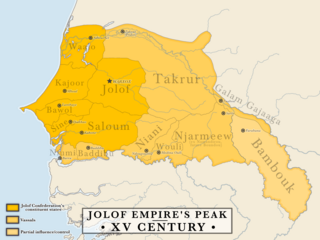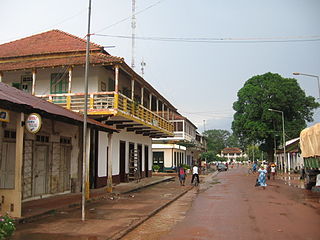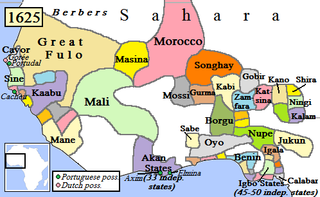
The Kingdom of Saloum was a Serer/Wolof kingdom in present-day Senegal. Its kings may have been of Mandinka/Kaabu origin. The capital of Saloum was the city of Kahone. It was a sister to the kingdom of Sine. Their history, geography and culture were intricately linked and it was common to refer to them as the Sine-Saloum.

The Jolof Empire, also known as Great Jolof, or the WolofEmpire, was a Wolof and Sereer confederacy state that ruled parts of West Africa, most precisely modern-day Senegal, Mali, Gambia and Mauritania from around the 12th century to 1549. Following the 1549 battle of Danki, its vassal states were fully or de facto independent; in this period it is known as the Jolof Kingdom.

Sunni Ali, also known as Si Ali, Sunni Ali Ber, born Ali Kolon, reigned from about 1464 to 1492 as the first king of the Songhai Empire and the 15th ruler of the Sunni dynasty.

Gabu is the largest town in eastern Guinea-Bissau and capital of the Gabu Region. Under the name Kansala, it was the capital of Kaabu.

Tambacounda is the largest city in eastern Senegal, 400 kilometres (250 mi) southeast of Dakar, and is the regional capital of the province of the same name. Its estimated population in 2007 was 78,800.

Janjanbureh or Jangjangbureh is a town, founded in 1823, on Janjanbureh Island, also known as MacCarthy Island, in the Gambia River in eastern Gambia. Until 1995, it was known as Georgetown and was the second largest town in the country. It is the capital of Janjanbureh Local Government Area, and the Janjanbureh district. The population of the Janjanbureh LGA was 127,333 at the 2013 population census.

Kaabu (1537–1867), also written Gabu, Ngabou, and N'Gabu, was a federation of Mandinka kingdoms in the Senegambia region centered within modern northeastern Guinea-Bissau, large parts of today's Gambia, and extending into Koussanar, Koumpentoum, and the Casamance in Senegal.

The Empire of Great Fulo, also known as the Denanke Kingdom or Denianke Kingdom, was a Pulaar kingdom of Senegal, which dominated the Futa Toro region from the early 16th century to 1776.
Tiramakhan Traore was a 13th-century general in the Mali Empire who served under Sundiata Keita. Traore expanded the power of Mali westward and set up the Kabu Empire. In his conquest of the region, he is reported to have defeated the Bainuk king Kikikor and annexed his state. The Guelowar royal family, including the royal family of Kaabu prior to their defeat at the Battle of Kansala, claimed descent from Tiramakhan Traore.
The Bainuk people are an ethnic group that today lives primarily in Senegal as well as in parts of Gambia and Guinea-Bissau.
The kingdom of Kasa, also known as Kasanga, was the dominant kingdom in lower Casamance during the 15th and 16th centuries. Many of the inhabitants of the realm were Bainuk or other native ethnicities, but it was ruled by a Mandinkized elite. The capital was at Brikama, on the south bank of the Casamance River.

The Saltigue, are Serer high priests and priestesses who preside over the religious ceremonies and affairs of the Serer people, such as the Xooy ceremony, the biggest event in the Serer religious calendar. They usually come from ancient Serer paternal families, and the title is inherited by birthright. In Serer country, Saltigue are always diviners.
Guelowar, also spelled Gelwar, Guelwar, Guelware, Gueleware or Gueloware, was a maternal dynasty in the pre-colonial Serer kingdoms of Sine and Saloum. They were from the Mandinka ethnic group. The offspring of Mandinka women and Serer men became the kings of Sine and Saloum. The dynasty lasted from the mid-14th century to 1969, the year both kings died.
Askia Ismail was the sixth ruler of the Songhai Empire from 1537 – 1539, and fourth from the Askia dynasty. He was the son of Askia Mohammad I, the founder of the Askia dynasty, and Maryam Daabu, a member of the Malian royal family captured in 1501.
Koli Tenguella was a Fulani warrior and leader who was pivotal in establishing the Empire of Great Fulo.
Tenguella was a Fula silatigi or chief who founded a short-lived state in the upper Senegal river valley, a precursor of the Empire of Great Fulo. He was referred to as the Great Fulo or Great king of the Fulos in Portuguese documents of the time.

Wuli was a Mandinka kingdom located on the north bank of the Gambia River in what is now the eastern portion of The Gambia and the Tambacounda region of Senegal. Ruled as an independent polity by the Wali family from the early 16th century until European colonialism in the late 19th, it controlled an important crossroads for trading routes linking the upper Niger river valley with the coast.
The Tenda or Tanda are an ethnolinguistic group living in the southern Senegal, northeastern Guinea-Bissau, and northern Guinea, comprising the Bassari, the Konyagui, the Bedik, and the Badiaranke.
The Nyancho were a royal maternal dynasty that ruled the West African empire of Kaabu.

Namandirou, also known as Njarmeew or Geremeo, was a kingdom in what is now eastern Senegal.








